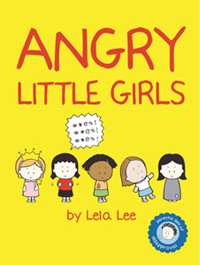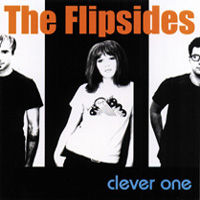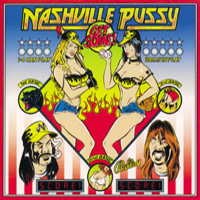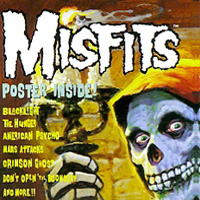 Angry Little Girls
Angry Little Girls
An interview with Lela Lee
by Jamie Kiffel
“There are a lot of different kinds of angry,” says Lela Lee, the author of the cult hit comic Angry Little Girls (www.angrylittlegirls.com). With five little girls who show off their assorted brands of anger by being pissed off, disenchanted, gloomy, dazed, and even, annoyingly enough, positive, Lee finds a way to resonate with anyone who’s ever been generally irritated by living. With her central character, “Kim, the angry little Asian girl,” based on Lee herself, the book reveals what’s really churning inside one cute, charming, molten-tempered female.
The obvious question here is: Why did you create a strip about an angry little girl?
In college, I went to an animation festival, and a friend took note of my irritation after watching the cartoons. So she challenged me to make a cartoon about myself. I made it, but sat on it for a long time because I was really embarrassed by my honesty. But four years later, I pulled it out of the drawer. I redid the first episode and added four more, and it was just by chance and luck that someone was saying they wanted materials to screen for a feature-length film in the festival, so they were able to use my short. I got reviewed in LA Weekly and the LA Times by some very well-known critics, and I was surprised, actually, that they even liked it. And when I started to get positive feedback and good reviews – well, it wasn’t really the reviews, but the people who came up to me after they saw it – it was their reaction and their comments: “I get this! This is just what I’m feeling!” I realized that I’d hit on a nerve of some sort, and just kept at it.
Back then, it was a video, but everyone who saw it kept referring to it as a comic strip. I didn’t have a comic strip then, and I decided I was going to spend some time and start to make a comic strip, because it’s a lot cheaper than using video equipment. The video was white construction paper, and I got my Crayola markers and made little stills, got thumbtacks, and put them on corkboard. I used a video camera on a tripod and filmed the stills. It was a very rudimentary way of doing it, but it worked, and I did the voice-over while I was shooting the image.
 So you were an art major?
So you were an art major?
I was a rhetoric major!
Why were you angry?
I was very angry as a young person coming of age. I think I was frustrated because my family was very strict, and there were a lot of expectations, being the daughter of very structured immigrant parents. It was very hard living in these two worlds: Not only didn’t my parents understand, but most people who were non-Asian perceived me as being different. They would treat me in a way that really irritated me… beyond.
In college, were you looking back in order to create this character, or were you still angry?
I was angry from before, and I was still angry in college. I was just all around angry, pretty much!
Although it’s called Angry Little Girls, I noticed that not all the characters necessarily seem angry. Are they?
When I was deciding to do a comic strip, I realized I needed to have more characters in order for The Angry Little Asian Girl to have a world. But I knew intuitively that if all the girls were angry, it would be annoying. So I thought about what anger is and how all people process it differently. For instance, some don’t get angry; they’re very Pollyanna about it.
You have a character called Wanda the Fresh Little Soul Sistah who’s always gushing positivity. How does that affect you? Is it annoying to you, or just to the characters in the strip?
I’m not so much angry anymore. I’m very hot and cold. When I’m happy, I’m very happy; when I’m angry, I’m very angry. These characters are all representative of my different moods, I guess. But in the comic world they live in, Wanda’s positivity is very annoying.
 When did you start feeling less angry?
When did you start feeling less angry?
I think when I started drawing the comic strip, because I had an outlet, and I started having fun with it. I realized, too, that I couldn’t always be angry, because it would only be a rant. I had ways to explore different ways of saying things, and I admire a lot of cartoonists who don’t hit you over the head, which anger can do. They employ irony, silence, non-responding. So I wanted to not get stuck and just be angry.
Which comics do you like?
Life is Hell, Jules Pfeiffer, and, of course, Charles Schulz.
It’s interesting that, like Schulz, you also chose to do children who are wise.
Partly because it just came out that way, starting with someone who’s going back… trying to see who I wish I were.
The Asian girl’s mom appears in the book, and I’m guessing that she’s representative of your real mom. Was talking about her an issue for you?
My mom kind of has an idea that I do this; she doesn’t really know very much about what it is. She just knows that I draw stuff. She thinks it’s rather a hobby.
I noticed that your dad doesn’t appear in the comic.
He’s kind of a rather quiet man, so there’s no drama there!
Do you have an especially close connection to any of the characters now?
I probably feel closest to the little Asian girl because that was my first character, sort of an organic spouting, I guess. I don’t know what you’d call it, but sort of an organic first child.
What’s your full-time job?
Full time, it’s mostly the comic strip. I’m really always doing it: Working on the strip, coming up with ideas, all the merchandising aspects. Then I like to read, since I feel like my job is to keep coming up with ideas, and reading inspires me.
Did you send this to publishers, or did they approach you?
I sent to them, they responded, and we started working together pretty quickly.
Do you have advice for people who are doing their own comics?
As long as the character is honest, that honesty can be felt by readers. When you start drawing for what you think people will like, that really hurts it.
(www.angrylittlegirls.com)



